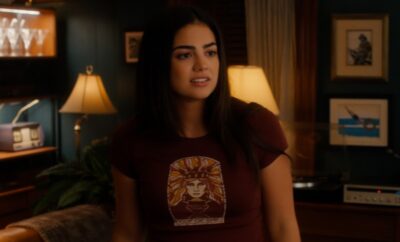Features
Will The CW Give Supergirl Room to Fly?
By: Kathryn Trammell
In 2006, TV networks The WB and UPN merged to become The CW, a broadcast television network that would eventually succeed in speaking to an audience of young millennial girls and women whose brand of feminism found liberation in the way it sexualized the female stars of its shows. The first CW show to truly find a foothold within this niche group of 18-34 year-old women was Gossip Girl, which turned criticisms such as “every parent’s nightmare” and “very bad for you” into its most marketable branding slogans. Audiences were intrigued by these criticisms, but young women were hooked. And while the network has since moved on from Gossip Girl, the formula for recreating its success remains the same: beautiful girls vying for the attention of beautiful boys and hurting each other in the process of getting what they want.
The problem with the success of this formula is that it created a misconception of what the typical “every girl” wanted to see on TV. Not all girls want to see soap operas play out on TV every evening, not all girls are interested in fighting each other to obtain that one perfect man or job and not all girls are satisfied with seeing their role on TV, sexually liberated or not, dominated by the male influences that surround them. This is why the addition of a show like Supergirl has the potential to succeed on The CW where its other shows have let its core audience down for so many years.
The CW has no shortage of superhero shows and when it was announced that Supergirl would be moved from CBS to The CW, fans immediately applauded the this change as being the best option for the show, which had seemed out of place as the only superhero show on CBS. Surely, fans thought, the move would only improve Supergirl by allowing the show the opportunity to finally have a home within a network that currently has on air three DC comic-related shows as well as multiple other superhuman shows such as iZombie, Supernatural and The Vampire Diaries.
Then some of the air was let out of the optimism balloon when entertainment writers started to opine about how exceptionally better Supergirl would be if The CW allowed the show to create crossover episodes in which the other heroes from its already successful shows visited Supergirl on her show’s own Earth. Some even went as far as to say that by not having the plotlines of these shows crossover The CW would miss out on the opportunity to help Supergirl get back to its DC roots.
That is when the balloon popped entirely when promo photos for Season Two of Supergirl were released featuring the Man of Steel himself standing side by side with Kara Zor-El. It is at this point that I return back to the original subject of The CW’s problematic formula. You see, when you are a major network whose predominant audience is young women (who at one point in time enjoyed watching shows like Gossip Girl and continue to watch shows like Vampire Diaries) the people running the network might begin to believe that its female viewers won’t be interested in a show unless that show features enough men to balance the female focus.
Being the antithesis to this perception is what made Supergirl such a fantastic breath of fresh air. When the show began, Kara (played by Melissa Benoist) had already “arrived” in every sense of the word. She knew who she was, what she was capable of doing and did not need anyone, especially a male figure, to train her, teach her or mentor her to become the person she already was. If anyone could be charged with having had a mentor relationship with Kara, it was Kat Grant (Calista Flockhart), whose mentorship never went beyond the boardroom. The show epitomized female empowerment. Its major villains were all women, the people who held the highest positions of power within the show were women and Kara’s most significant relationship was with her sister Alex (Chyler Leigh), another strong and powerful woman. Even more important is that this show passed the Bechdel test with flying colors, which isn’t a trait that the limited number of other shows featuring multiple female leads can easily boast.
So, when critics suggest that crossovers could help Supergirl get back to its roots, I would like to remind them that its roots were already established in Season One when it allowed Supergirl the chance to lead her own show. To assume that adding Superman (Tyler Hoechlin), The Flash or Arrow to the mix would improve it in any way is to deviate from those roots and would greatly destroy any chance for young women to see a rare show that allows true female empowerment to thrive. In fact, according the Media, Diversity & Social Media Change Initiative Report for 2015, last year only 23% of the stories being televised were gender-balanced and that the one aspect that makes Supergirl so exciting for the fans of its move to The CW is that this series may get the chance to employ more men is disheartening.
But I am not the only one who feels this way. When the topic of female empowerment was addressed during a Supergirl panel at DragonCon 2016, the panel’s only male speaker expressed how tired he’d become from being surrounded by the rhetoric that women be represented equally across all aspects of life, including the entertainment industry. This, he said, was why he hoped The CW would allow men to enter the folds of the show because he didn’t want Supergirl “to be all about women.” Luckily, a real-life superheroine by the name of Cammien Ray was also on the panel and she took the speaker’s comments to task saying, “I have no problem with Supergirl being all about women . . . I would like her mentors to be women, her primary familial relationships to be women, her adversaries to be women . . . I don’t mind if men are not and are never the focus; they have more than enough space where they are already.” While she is absolutely right, it’s the post-feminist fatigue expressed by the male speaker and The CW’s track record with developing female leads that has me and many others worried about Supergirl’s fate on its new network.
Take for example the show The 100. At the beginning of its third season, The CW’s most diverse show featured a plethora of female characters that held various levels of power within the show’s storyline. By the end of Season Three, three characters who were all female leaders within the show’s storyline had died – their deaths belonging to either the “Fridging” trope or the “Bury Your Gays” trope. The other female leads had been stripped of their leadership roles by either injury or male influence (or both). Across all of its shows, The CW consistently puts its female leads and even its supporting female characters in the middle of love triangles that give the network exactly the buzz they want and need when “shipping” wars break out on social media. But Supergirl is better than deadly tropes and shipping wars. To turn its primary slogan against itself, Supergirl “dares to defy” everything The CW thinks it represents and should not pander to the network’s faulty assumptions of what its niche audience wants to see represented on TV.
At this point, the show could go one of two ways. First, it could continue to give in to its tired view of the interests of its female viewers and the post-feminist fatigue felt by its male viewers and incorporate into the show a Superman character who exists to train Kara to be a better hero, to rescue her when she needs rescuing and to save the world when she can’t save it all by herself. They could also bring in various superheroes from their other shows to help elevate Kara’s successes and to potentially give her more love interests than she already has. The second option is that the CW could see the potential that already exists in Supergirl’s empowered roots and further develop them by using Superman as someone who occasionally shows up to help defeat villains as an equal member of Kara’s team, but NOT as the team’s leader. And if crossovers are necessary, it would be exciting and almost revolutionary to see Kara interact with other female superheroes like White Canary (Caity Lotz) and Hawkgirl (Ciara Renee) or any other superheroine that has yet to be licensed by any network for that matter.
The CW has a rare opportunity. In 2015, it led as one of the most inclusive networks on TV and claimed that “hiring practices behind the camera for writers and show creators that approach balance” led to such high scores from the Media, Diversity & Social Media Change Initiative. While these practices are noteworthy, it’s one thing to give female writers and characters room to speak. It’s an entirely different thing altogether to actually hear them and to respect them for what they have to say. By taking on Supergirl, the CW has the chance to truly create a meaningful space for its primary audience by hearing and respecting their voices – to end the lip service of “daring to defy” the norm and to instead end the cycle of male-led superhero shows and movies by giving superheroines and the young women who view them as role models a true sense of equal representation. If that doesn’t pan out, we can always watch Xena again.





You must be logged in to post a comment Login